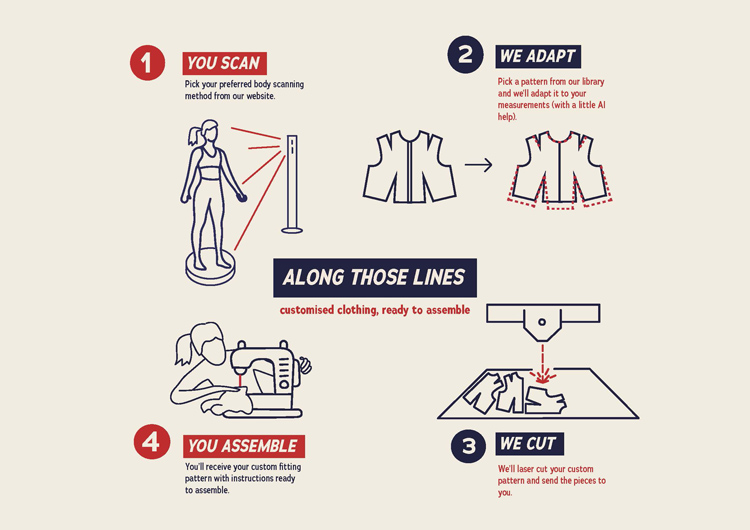Four student projects tackling environmental issues with creativity
Environmental charity Hubbub asked university students to tackle fast fashion, water waste and air pollution – these are some of our favourite efforts.
Late last year, environmental charity Hubbub tasked UK design students to develop solutions to three of the most pressing issues facing our environment: fast fashion, water waste and air pollution.
The challenge to students was the second year of Hubbub’s Design By Nature – a competition which offers up a series of “living briefs” based on the continually changing environmental circumstances that affect our day to day life.
Life in the UK has changed considerably since the living briefs were initially set, with the onset of the coronavirus pandemic forcing the country into lockdown and students out of university buildings. Hubbub has now unveiled the winners of the competition, having judged entries this year remotely. These are the ones that caught Design Week’s eye.

Sew Concious – Samantha Supan, Brunel University London
Aiming to tackle the old-fashioned and technically challenging assumptions around mending clothes, Samantha Supan has developed Sew Concious – a smart-technology powered sewing machine targeted at Gen Z consumers.
The product, made from sustainably sourced recycled plastic, has been designed as an approachable way for young people to get into the habit of fixing clothes, rather than throwing them away and buying new ones.
After conducting a product assessment of a Singer machine, Supan developed a design fit for a generation that has not previously engaged in sewing. Elements of a traditional machine are present in the Sew Conscious product, but are supported by smart tech like sensors which can detect when users may be making an incorrect step via a touch screen panel.
It has also been designed to be foldable for easy storage, thereby addressing another barrier for young would-be sewers: that they don’t have the space to own a sewing machine. Hubbub is now working with Supan to explore how funding could be attracted to move the idea forward.

OptiAir – Betsy Cousins, Loughborough University
Answering the air pollution brief, Betsy Cousins has developed a hardhat with a built-in respirator to help protect construction workers from dangerous ambient air particles. Research into the topic revealed to Cousins that one-time respirators, the most common of their kind in the industry, are not fit for purpose: she says they are inefficient, bad for the environment, uncomfortable for wearers and not considered essential PPE.
The negatives mentioned all add up to many construction workers opting to forgo wearing them, putting their long term health at risk in the process. OptiAir then seeks to change this, by integrating a respirator into a hardhat – a piece of equipment that is considered essential PPE.
It works using sensors attached to the hat, which detect the air quality around the worker. When air quality is poor, a dual fan system snaps into place to deliver clean air to workers and create a “clean air shield” to protect them from breathing in any harmful pollutants.

Along Those Lines – Lisa Kalt and Teresa Raina, Glasgow School of Art
Lisa Kalt and Teresa Raina describe Along Those Lines as being somewhere between IKEA and a tailor. It’s a platform that offers customised patterns and laser-cut fabric pieces, because the duo believe having a hand in making their own, well-fitting clothes will lead consumers to hang on to them longer.
Using a 3D scanning and AI-powered software, patterns are adjusted to fit each body perfectly. These measurements are then used to laser-cut fabric pieces, which are then sent to consumers for them to assemble at home.

Scrub – Sarah Everett, Loughborough University
Scrub is a product for student households, an environment that Sarah Everett has identified as being particularly susceptible to wasting water. The system is designed to use the leftover water from cooking vegetables to create lifestyle products like liquid hand soaps, hand creams, washing up liquid and surface cleaners.
The product, Everett says, reduces the need for households to further buy into the cosmetic and toiletries industry, which uses both large amounts of water in its manufacturing processes and single use plastic in its packaging.
Users pour the water into the product, which is connected to a series of reusable dispensers that contain ingredients to create different toiletry products. To fill the dispensers with water, users need only push down and then shake to mix. The product is then supported with an app, on which users can buy ingredients to make custom products.

Other winners
Mini Kitchen Aquarium – Langyuan Ma, Loughborough University: A digital screen that projects an aquarium into a user’s kitchen, representing the household’s water usage (and wastage) in a tangible way.
Lava Aqua X – Joanna Power & Paramveer Bhachu, Brunel University London: A product that helps students wash their clothes using less water than a traditional washing machine, with water collected from a shower.
Adapto – Beatriz Dantas, University of Northampton: A patching system for clothes that requires no sewing skills, allowing young people to more easily mend and customise their clothes, instead of buying new ones.
-
Post a comment





